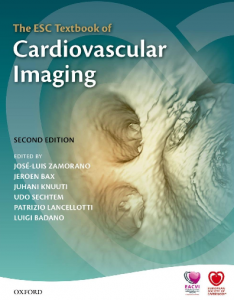ESC textbook of cardiovascular imaging, 2nd edition
 Editors: Zamorano JL, Bax J, Knuuti J, Sechtem U,
Editors: Zamorano JL, Bax J, Knuuti J, Sechtem U,
Lancellotti P, Badano L
Publisher: Oxford University Press, Oxford, 2015
ISBN: 978-0-19-870334-1 Price: £115
The second edition of the ESC textbook of cardiovascular imaging is a compendium of imaging expertise. The list of contributors alone should be enough to guarantee that there is something to learn for most involved in cardiology imaging.
The strengths are that it takes someone with a very limited knowledge of any of the individual modalities and walks them through the basics of how images are formed, through to making advanced diagnostic decisions. Some sections manage to seamlessly weave together fundamentals of clinical cardiology with European Society of Cardiology (ESC) guidelines and imaging characteristics, such as valvular heart disease. There is little overlap and much detail in the heart failure and cardiomyopathy sections that again encompasses teaching the topics themselves as well as the imaging detail. The more niche topics are particularly well written with truly multi-modality approaches. Examples include the distinction between restrictive and constrictive pericardial disease, and the imaging in cardiac resynchronisation sections.
Larger sections where there is more scope for competition between imaging modalities, sees the sales pitch of the experts. Assessment of coronary artery disease has the potential to end up as a battle to see who can quote the best sensitivity and specificity data, but actually allows the discerning reader to evaluate these whilst identifying limitations. The wealth of information, including documented percentage of at-risk myocardium and prognostication, is clear from the well-organised nuclear cardiology chapter, which clearly has the most historical data to validate. The cardiovascular magnetic resonance chapter provides a solid foundation for comparison in the functional assessment of coronary disease. Brief mention is made of the few head-to-head comparisons, and one has to reference back to the basics chapters to compare radiation doses.
Repetition is sometimes a problem. The modality-specific viability chapters each start off with their own description of the pathophysiology of stunning and hibernation. Whilst it is fascinating to see the different viewpoints, it is conceivable that so many descriptions of the same thing may leave the contiguous reader slightly frustrated if not confused. In addition, some areas spend a large amount of effort in unnecessary detail whilst omitting smaller but vital points. For example, the echocardiography section focuses on angles to obtain the ideal images − ‘a clockwise rotation of exactly 60° can be performed to visualise a correct 2-chamber’ − but has no disclaimer that morphology varies, especially in the elderly, or in fact that a protractor is necessary to perform an echo. In addition, not mentioning the importance of respiratory variation when obtaining images will seem bizarre to anyone who practices echocardiography.
The most glaring omission is the exceptionally brief and unenlightening description of imaging for percutaneous aortic valve replacement, a truly multi-modality phenomenon (and perhaps a reason for the oversight). This is even more notable when compared to the well-illustrated and lengthy section on percutaneous mitral valve clips.
Overall, despite some omissions and repetition there is much very useful information in this book and it gives an excellent account of how to assess, quantify and, in some cases, manage both common and rare cardiac conditions.
G Sunthar Kanaganayagam
Imaging Fellow
Hammersmith Hospital, London
